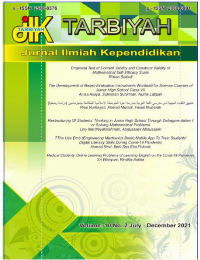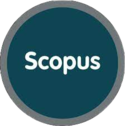The Development of Based Evaluation Instruments Wordwall for Science Courses of Junior High School Class VII
DOI:
https://doi.org/10.18592/tarbiyah.v10i2.4566Abstract
The evaluation instrument or evaluation tool is a tool that meets academic requirements, so that it can be used as a measuring tool or data collection about a variable. Based on the results of the analysis of the need for evaluation instruments used by educators in learning, the teacher still uses paper and google forms for evaluation. This research aims to develop a Wordwall-based evaluation instrument and to determine student responses to wordwall-based evaluation instruments. The type of research used is Research and Development (R&D). The development model used is the Borg and Gall model adapted by Sugiyono with 8 stages consisting of needs analysis, data collection, product design, design validation, design revision, small-scale testing, product revision and user testing. The results of the development of a wordwall-based evaluation instrument for class VII junior high school science subjects obtained values from the validation of material, media and language experts of 80%, 98.5% and 96.65% with very feasible categories. Whereas for the results of the trial use, the average result of the student's questionnaire response was 87.9% with the very interesting instrument category.References
Ayu Refsi Dewindra, V. dan endang susilaningsih. (2020). Pengembangan Instrumen Penilaian Berbasis Web Pada Keterampilan Presentasi Proyek Materi Minyak Bumi. Jurnal Pendidikan Kimia Unesa, 9(1), 1-8.Http:// doi.org/10.15294/USEJ.V10I2.43982
Arikunto, S. (2011). Dasar–Dasar Evaluasi Pendidikan Evaluasi Pendidikan.Edisi Revisi, Cetakan kesebelas, Jakarta : Bumi Aksara.
Bintiningtiyas, N., & Lutfi, A. (2016). Pengembangan Permainan Varmintz Chemistry Sebagai Media Pembelajaran Pada Materi Sistem Periodik Unsur. Unesa Journal of Chemical Education, 5(2), 302–308. https://doi.org/10.26740/ujced.v5n2.p%25p
Cahya, D, K. (2018). Pengembangan Alat Evaluasi Menggunakan Aplikasi Kahoot Pada Pembelajaran Matematika Kelas X. SKRIPSI. Fakultas Tarbiyah dan Keguruan Universitas Negeri Islam Raden Patah.
Lestari, P. E., Purwanto, A., & Sakti, I. (2019). Pengembangan Instrumen Tes Keterampilan Pemecahan Masalah Pada Konsep Usaha Dan Energi Di Sma. Jurnal Kumparan Fisika, 2(3), 161–168. https://doi.org/10.33369/jkf.2.3.161-168
Noermanzah, N., & Friantary, H. (2019). Development of Competency-Based Poetry Learning Materials for Class X High Schools. 8, 6631–6638. https://doi.org/10.35940/ijrteD8855.118419
Nuryadi, N., & Khuzaini, N. (2017). Keefektifan Media Matematika Virtual Berbasis Teams Game Tournament Ditinjau Dari Cognitive Load Theory. Jurnal Mercumatika : Jurnal Penelitian Matematika Dan Pendidikan Matematika, 2(2), 57–68. https://doi.org/10.26486/jm.v2i2.370
Fatmawati, A. (2016). Pengembangan Perangkat Pembelajaran Konsep Pencemaran Lingkungan Menggunakan Model Pembelajaran Berdasarkan Masalah Untuk SMA Kelas X. Edu Sains: Jurnal Pendidikan Sains Dan Matematika IAIN Palangka Raya, 4(2). https://doi.org/10.23971/eds.v4i2.512
Purwanto, Ngalim. (2010). Prinsip- prinsip dan Teknik Evaluasi Pengajaran. Bandung: PT Remaja Rosdakarya
Ratnawulan, E & Rusdiana. (2017). Evaluasi Pembelajaran. Bandung: Penerbit CV Pustaka Setia.
Setiawan, S. (2015). Kelas asik dengan games: 30 games untuk pembelajaran. Jakarta: PT. Gramedia
Supriatini. Refson, M. (2020). Pengembangan Alat Evaluasi Menggunakan Kahoot Pada Pembelajaran Bahasa Indonesia Untuk Siswa Kelas ViI. Jurnal Bisastra Palembang, 4(1), 48–62. https://doi.org/https://doi.org/10.32502/jbs.v4i1.2206
Undang-Undang Republik Indonesia Nomor 20 Tahun 2003. Jakarta: Depdiknas
Vaidya, S., Ambad, P., & Bhosle, S. (2018). Industry 4.0 - A Glimpse. Procedia Manufacturing, 20, 233–238. https://doi.org/10.1016/j.promfg.2018.02.034
Yasa, A. D. (2020). Pengembangan E-Evaluation Berbasis Aplikasi Hot Potatoes Untuk Siswa Kelas V Sekolah Dasar. Jurnal Ilmiah Sekolah Dasar, 4(1), 26. https://doi.org/10.23887/jisd.v4i1.23987
Downloads
Published
How to Cite
Issue
Section
License
Authors retain copyright and grant the journal right of first publication with the work simultaneously licensed under a Creative Commons Attribution 4.0 International License that allows others to share the work with an acknowledgment of the work's authorship and initial publication in this journal.




